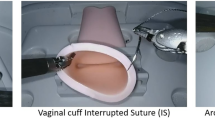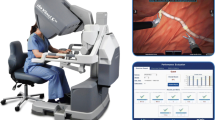Abstract
Background
The clinical application of robotic-assisted surgery (RAS) is rapidly increasing. The da Vinci Surgical System™ is currently the only commercially available RAS system. The skills necessary to perform robotic surgery are unique from those required for open and laparoscopic surgery. A validated laparoscopic surgical skills curriculum (fundamentals of laparoscopic surgery or FLS™) has transformed the way surgeons acquire laparoscopic skills. There is a need for a similar skills training and assessment tool specific for robotic surgery. Based on previously published data and expert opinion, we developed a robotic skills curriculum. We sought to evaluate this curriculum for evidence of construct validity (ability to discriminate between users of different skill levels).
Methods
Four experienced surgeons (>20 RAS) and 20 novice surgeons (first-year medical students with no surgical or RAS experience) were evaluated. The curriculum comprised five tasks utilizing the da Vinci™ Skills Simulator (Pick and Place, Camera Targeting 2, Peg Board 2, Matchboard 2, and Suture Sponge 3). After an orientation to the robot and a period of acclimation in the simulator, all subjects completed three consecutive repetitions of each task. Computer-derived performance metrics included time, economy of motion, master work space, instrument collisions, excessive force, distance of instruments out of view, drops, missed targets, and overall scores (a composite of all metrics).
Results
Experienced surgeons significantly outperformed novice surgeons in most metrics. Statistically significant differences were detected for each task in regards to mean overall scores and mean time (seconds) to completion.
Conclusions
The curriculum we propose is a valid method of assessing and distinguishing robotic surgical skill levels on the da Vinci Si™ Surgical System. Further study is needed to establish proficiency levels and to demonstrate that training on the simulator with the proposed curriculum leads to improved robotic surgical performance in the operating room.
Similar content being viewed by others
References
Kenngott HG, Fischer L, Nickel F, Rom J, Rassweiler J, Müller-Stich BP (2012) Status of robotic assistance—a less traumatic and more accurate minimally invasive surgery? Langenbecks Arch Surg 397(3):333–341
Annual report 2010 (2011) Intuitive Surgical Inc
Okrainec A, Soper NJ, Swanstrom LL, Fried GM (2011) Trends and results of the first 5 years of fundamentals of laparoscopic surgery (FLS) certification testing. Surg Endosc 25(4):1192–1198
Hung AJ, Zehnder P, Patil MB, Cai J, Ng CK, Aron M, Gill IS, Desai MM (2011) Face, content and construct validity of a novel robotic surgery simulator. J Urol 186:1019–1025
Kenney PA, Wszolek MF, Gould JJ, Libertino JA, Moinzadeh A (2009) Face, content, and construct validity of dV-trainer, a novel virtual reality simulator for robotic surgery. Urology 73(6):1288–1292
Lyons C, Goldfarb D, Jones SL, Badhiwala N, Miles B, Link R, Dunkin BJ (2013) Which skills really matter? Proving face, content, and construct validity for a commercial robotic simulator. Surg Endosc 27(6):2020–2030
Grantcharov TP, Kristiansen VB, Bendix J, Bardram L, Rosenberg J, Funch-Jensen P (2004) Randomized clinical trial of virtual reality simulation for laparoscopic skills training. Br J Surg 91:146–150
Seymour NE, Gallagher AG, Roman SA, O’Brien MK, Bansal VK, Andersen DK, Satava RM (2002) Virtual reality training improves operating room performance: results of a randomized, double-blinded study. Ann Surg 236:458–463
Sroka G, Feldman LS, Vassiliou MC, Kaneva PA, Fayez R, Fried GM (2010) Fundamentals of laparoscopic surgery simulator training to proficiency improves laparoscopic performance in the operating room: a randomized controlled trial. Am J Surg 199(1):115–120
Beyer L, De Troyer J, Mancini J, Bladou F, Berdah SV, Karsenty G (2011) Impact of laparoscopy simulator training on the technical skills of future surgeons in the operating room: a prospective study. Am J Surg 202(3):265–272
Anderson E, Chang DC, Parsons JK, Talamini MA (2012) The first national examination of outcomes and trends in robotic surgery in the United States. J Am Coll Surg 215(1):107–114
Gurusamy KS, Samraj K, Fusai G, Davidson BR (2009) Robot assistant for laparoscopic cholecystectomy. Cochrane Database Syst Rev 21(1):CD006578
Maeso S, Reza M, Mayol JA, Blasco JA, Guerra M, Andradas E, Plana MN (2010) Efficacy of the da Vinci surgical system in abdominal surgery compared with that of laparoscopy: a systematic review and meta-analysis. Ann Surg 252:254–262
Tanner L (2013) Robot hot among surgeons but FDA taking a fresh look. http://bigstory.ap.org/article/robot-hot-among-surgeons-fda-taking-new-look. Accessed 9 Aug 2013
Intuitive Surgical Form 10-k filed 2/4/13. http://phx.corporate-ir.net/phoenix.zhtml?c=122359&p=irol-sec. Accessed 9 Aug 2013
Perrenot C, Perez M, Nguyen T, Jehl J, Felblinger J, Bresler L, Hubert J (2012) The virtual reality simulator dV-trainer is a valid assessment tool for robotic surgical skills. Surg Endosc 26:2587–2593
Kenney PA, Wszolek MF, Gould JJ, Libertino JA, Moinzadeh A (2009) Face, content, and construct validity of dV-trainer: a novel virtual reality simulator for robotic surgery. Urology 73(6):1288–1292
Sethi AS, Peine WJ, Mohammadi Y, Sundaram CP (2009) Validation of a novel virtual reality robotic simulator. J Endourol 23(3):503–508
Lendvay TS, Casale P, Sweet R, Peters C (2008) VR robotic surgery: randomized blinded study of the dV-trainer robotic simulator. Stud Health Technol Inform 132:242–244
Acknowledgments
The authors acknowledge Dario Icardi, Robotic Specialist for Froedtert Hospital, and Froedtert Memorial Lutheran Hospital, Milwaukee, WI, and finally the Medical College of Wisconsin Department of Surgery for their generous support of this project.
Disclosures
Michael Connolly, Johnathan Seligman, Dr. Andrew Kastenmeier, Dr. Mathew Goldblatt, and Dr. Jon Gould have no relevant conflicts of interest with this work.
Author information
Authors and Affiliations
Corresponding author
Rights and permissions
About this article
Cite this article
Connolly, M., Seligman, J., Kastenmeier, A. et al. Validation of a virtual reality-based robotic surgical skills curriculum. Surg Endosc 28, 1691–1694 (2014). https://doi.org/10.1007/s00464-013-3373-x
Received:
Accepted:
Published:
Issue Date:
DOI: https://doi.org/10.1007/s00464-013-3373-x




